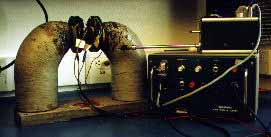
The goals of this experiment are to observe the resonance condition for protons in an applied magnetic field, demonstrating the nuclear magnetic resonance effect, and to observe resonance for other more complicated nuclei
 |
|
The goals of this experiment are to observe the resonance condition for protons in an applied magnetic field, demonstrating the nuclear magnetic resonance effect, and to observe resonance for other more complicated nuclei |
 |
The first part of the experiment involves finding the proton resonance frequency for a permanent magnet. This is done by inserting a small glycerol probe in the center of a permanent magnet, making appropriate equipment adjustments and searching for the resonance frequency with a recieving device. Once found, the resonance frequency can then be used to calcute the z-component of the magnetic moment of the proton. |
NMR lab equipment |
|
The procedure is then repeated using an electromagnet. This allows location of the resonant frequency by adjusting the electromagnet current rather than scanning with a reciever. Upon location of the resonant frequency, measurements of the electromagnet current can be associated with values of the magnetic field of the resonant condition, as calculated from accepted values of the magnetic moment of the proton. |
|
The next part of the experiment is to attempt identification of an unknown nucleus by finding its resonant frequency. Once a resonant frequency is found, B fields, determined in the previous parts, can be used to calculate nuclei magnetic moments. The unknown nuclei can now be identified by comparing calculated magnetic moments to tables of magnetic moments of nuclei. |
 |

| H alpha Isotope Shift | Sodium D Line Splitting | ||
| Scanning Tunneling Microscope | IRThermography | ||
| Hall Effect | Franck-Hertz | ||
| Alpha Particles | Nuclear Magnetic Resonance |
Senior Lab Home | NMT Physics Home |